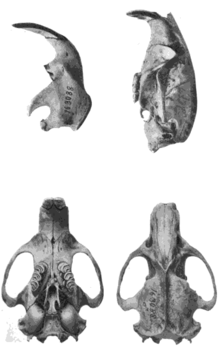Tachyoryctes rex
| King African mole-rat | |
|---|---|
 |
|
| Holotype skull and mandible of Tachyoryctes rex. | |
| Scientific classification | |
| Kingdom: | Animalia |
| Phylum: | Chordata |
| Class: | Mammalia |
| Order: | Rodentia |
| Family: | Spalacidae |
| Genus: | Tachyoryctes |
| Species: | T. rex |
| Binomial name | |
|
Tachyoryctes rex Heller, 1910 |
|
The King African mole-rat,King mole-rat, or Alpine mole-rat, (Tachyoryctes rex) is a burrowing rodent in the genus Tachyoryctes of family Spalacidae. It only occurs high on Mount Kenya, where it is common. Originally described as a separate species related to Aberdare Mountains African mole-rat, (T. audax) in 1910, some classify it as the same species as the East African mole-rat, (T. splendens).
It is a very large, brownish species, with head and body length ranging from 222 to 268 mm (8.7 to 10.6 in). The young are dark with irregular white patches on their underparts. The animal builds large burrows and perhaps associated mounds and eats plant roots.
In 1909, John Alden Loring collected the holotype while on the Smithsonian-Roosevelt African Expedition led by Theodore Roosevelt. The next year, Edmund Heller described the species as Tachyoryctes rex; he thought it most closely related to another Kenyan species, T. audax. In 1919, Ned Hollister provided additional information using more material, and affirmed the relationship between T. rex and T. audax. He noted that the two were similar in coloration, but that T. rex was much larger; according to Heller, T. audax is somewhat darker in color. Since 1974, some taxonomic works have included T. rex and many other Tachyoryctes species in T. splendens, though without evaluation of the distinctive characters of the previously recognized species. The 2009 IUCN Red List follows this arrangement, but the 2005 third edition of Mammal Species of the World describes T. rex as a "distinctive species".
...
Wikipedia
